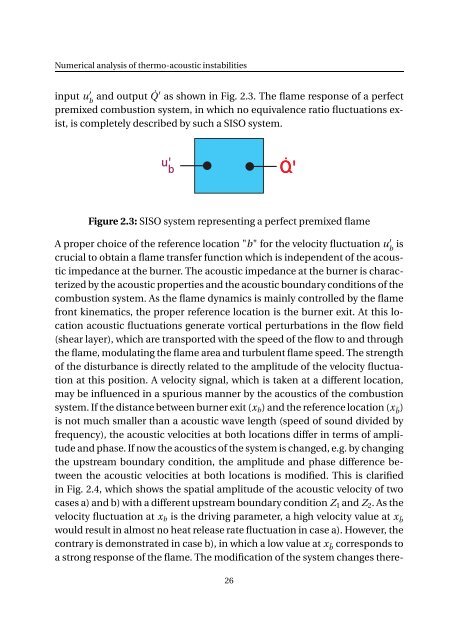Impact of fuel supply impedance and fuel staging on gas turbine ...
Impact of fuel supply impedance and fuel staging on gas turbine ...
Impact of fuel supply impedance and fuel staging on gas turbine ...
Create successful ePaper yourself
Turn your PDF publications into a flip-book with our unique Google optimized e-Paper software.
Numerical analysis <str<strong>on</strong>g>of</str<strong>on</strong>g> thermo-acoustic instabilities<br />
input u ′ b <str<strong>on</strong>g>and</str<strong>on</strong>g> output ˙Q ′ as shown in Fig. 2.3. The flame resp<strong>on</strong>se <str<strong>on</strong>g>of</str<strong>on</strong>g> a perfect<br />
premixed combusti<strong>on</strong> system, in which no equivalence ratio fluctuati<strong>on</strong>s exist,<br />
is completely described by such a SISO system.<br />
u' b<br />
.<br />
Q'<br />
Figure 2.3: SISO system representing a perfect premixed flame<br />
A proper choice <str<strong>on</strong>g>of</str<strong>on</strong>g> the reference locati<strong>on</strong> "b" for the velocity fluctuati<strong>on</strong> u ′ b is<br />
crucial to obtain a flame transfer functi<strong>on</strong> which is independent <str<strong>on</strong>g>of</str<strong>on</strong>g> the acoustic<br />
<str<strong>on</strong>g>impedance</str<strong>on</strong>g> at the burner. The acoustic <str<strong>on</strong>g>impedance</str<strong>on</strong>g> at the burner is characterized<br />
by the acoustic properties <str<strong>on</strong>g>and</str<strong>on</strong>g> the acoustic boundary c<strong>on</strong>diti<strong>on</strong>s <str<strong>on</strong>g>of</str<strong>on</strong>g> the<br />
combusti<strong>on</strong> system. As the flame dynamics is mainly c<strong>on</strong>trolled by the flame<br />
fr<strong>on</strong>t kinematics, the proper reference locati<strong>on</strong> is the burner exit. At this locati<strong>on</strong><br />
acoustic fluctuati<strong>on</strong>s generate vortical perturbati<strong>on</strong>s in the flow field<br />
(shear layer), which are transported with the speed <str<strong>on</strong>g>of</str<strong>on</strong>g> the flow to <str<strong>on</strong>g>and</str<strong>on</strong>g> through<br />
the flame, modulating the flame area <str<strong>on</strong>g>and</str<strong>on</strong>g> turbulent flame speed. The strength<br />
<str<strong>on</strong>g>of</str<strong>on</strong>g> the disturbance is directly related to the amplitude <str<strong>on</strong>g>of</str<strong>on</strong>g> the velocity fluctuati<strong>on</strong><br />
at this positi<strong>on</strong>. A velocity signal, which is taken at a different locati<strong>on</strong>,<br />
may be influenced in a spurious manner by the acoustics <str<strong>on</strong>g>of</str<strong>on</strong>g> the combusti<strong>on</strong><br />
system. If the distance between burner exit (x b ) <str<strong>on</strong>g>and</str<strong>on</strong>g> the reference locati<strong>on</strong> (x ˜b)<br />
is not much smaller than a acoustic wave length (speed <str<strong>on</strong>g>of</str<strong>on</strong>g> sound divided by<br />
frequency), the acoustic velocities at both locati<strong>on</strong>s differ in terms <str<strong>on</strong>g>of</str<strong>on</strong>g> amplitude<br />
<str<strong>on</strong>g>and</str<strong>on</strong>g> phase. If now the acoustics <str<strong>on</strong>g>of</str<strong>on</strong>g> the system is changed, e.g. by changing<br />
the upstream boundary c<strong>on</strong>diti<strong>on</strong>, the amplitude <str<strong>on</strong>g>and</str<strong>on</strong>g> phase difference between<br />
the acoustic velocities at both locati<strong>on</strong>s is modified. This is clarified<br />
in Fig. 2.4, which shows the spatial amplitude <str<strong>on</strong>g>of</str<strong>on</strong>g> the acoustic velocity <str<strong>on</strong>g>of</str<strong>on</strong>g> two<br />
cases a) <str<strong>on</strong>g>and</str<strong>on</strong>g> b) with a different upstream boundary c<strong>on</strong>diti<strong>on</strong> Z 1 <str<strong>on</strong>g>and</str<strong>on</strong>g> Z 2 . As the<br />
velocity fluctuati<strong>on</strong> at x b is the driving parameter, a high velocity value at x ˜b<br />
would result in almost no heat release rate fluctuati<strong>on</strong> in case a). However, the<br />
c<strong>on</strong>trary is dem<strong>on</strong>strated in case b), in which a low value at x ˜b corresp<strong>on</strong>ds to<br />
a str<strong>on</strong>g resp<strong>on</strong>se <str<strong>on</strong>g>of</str<strong>on</strong>g> the flame. The modificati<strong>on</strong> <str<strong>on</strong>g>of</str<strong>on</strong>g> the system changes there-<br />
26
















